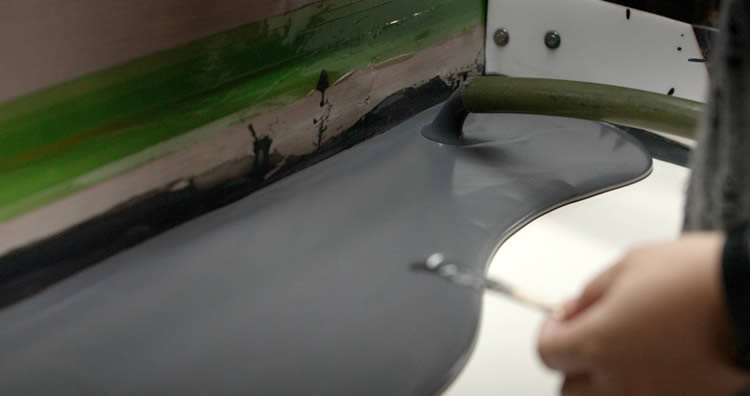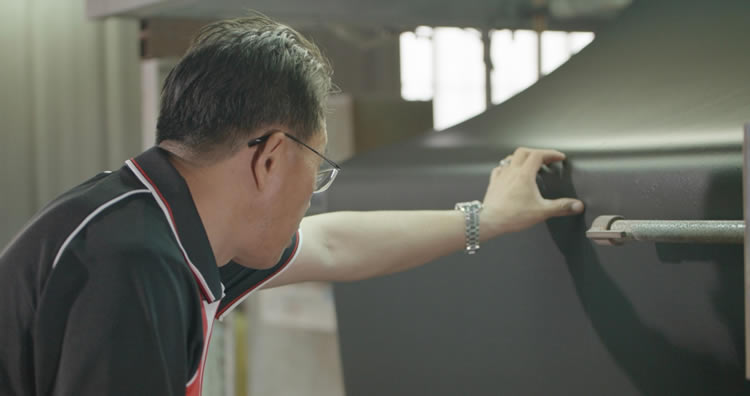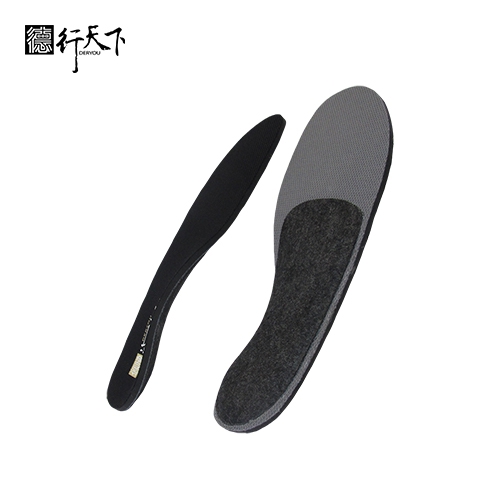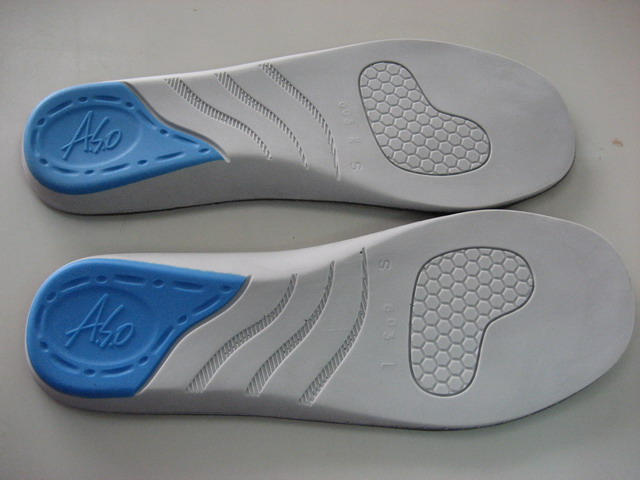
GuangXin Industrial Co., Ltd. is a specialized manufacturer dedicated to the development and production of high-quality insoles.
With a strong foundation in material science and footwear ergonomics, we serve as a trusted partner for global brands seeking reliable insole solutions that combine comfort, functionality, and design.
With years of experience in insole production and OEM/ODM services, GuangXin has successfully supported a wide range of clients across various industries—including sportswear, health & wellness, orthopedic care, and daily footwear.
From initial prototyping to mass production, we provide comprehensive support tailored to each client’s market and application needs.
At GuangXin, we are committed to quality, innovation, and sustainable development. Every insole we produce reflects our dedication to precision craftsmanship, forward-thinking design, and ESG-driven practices.
By integrating eco-friendly materials, clean production processes, and responsible sourcing, we help our partners meet both market demand and environmental goals.


At GuangXin Industrial, our core strength lies in our deep expertise and versatility in insole and pillow manufacturing. We specialize in working with a wide range of materials, including PU (polyurethane), natural latex, and advanced graphene composites, to develop insoles and pillows that meet diverse performance, comfort, and health-support needs.
Whether it's cushioning, support, breathability, or antibacterial function, we tailor material selection to the exact requirements of each project-whether for foot wellness or ergonomic sleep products.
We provide end-to-end manufacturing capabilities under one roof—covering every stage from material sourcing and foaming, to precision molding, lamination, cutting, sewing, and strict quality control. This full-process control not only ensures product consistency and durability, but also allows for faster lead times and better customization flexibility.
With our flexible production capacity, we accommodate both small batch custom orders and high-volume mass production with equal efficiency. Whether you're a startup launching your first insole or pillow line, or a global brand scaling up to meet market demand, GuangXin is equipped to deliver reliable OEM/ODM solutions that grow with your business.



GuangXin offers exceptional flexibility in customization and OEM/ODM services, empowering our partners to create insole products that truly align with their brand identity and target market. We develop insoles tailored to specific foot shapes, end-user needs, and regional market preferences, ensuring optimal fit and functionality.
Our team supports comprehensive branding solutions, including logo printing, custom packaging, and product integration support for marketing campaigns. Whether you're launching a new product line or upgrading an existing one, we help your vision come to life with attention to detail and consistent brand presentation.
With fast prototyping services and efficient lead times, GuangXin helps reduce your time-to-market and respond quickly to evolving trends or seasonal demands. From concept to final production, we offer agile support that keeps you ahead of the competition.
Quality is at the heart of everything we do. GuangXin implements a rigorous quality control system at every stage of production—ensuring that each insole meets the highest standards of consistency, comfort, and durability.
We provide a variety of in-house and third-party testing options, including antibacterial performance, odor control, durability testing, and eco-safety verification, to meet the specific needs of our clients and markets.
Our products are fully compliant with international safety and environmental standards, such as REACH, RoHS, and other applicable export regulations. This ensures seamless entry into global markets while supporting your ESG and product safety commitments.
At GuangXin Industrial, we are committed to integrating ESG (Environmental, Social, and Governance) values into every step of our manufacturing process. We actively pursue eco-conscious practices by utilizing eco-friendly materials and adopting low-carbon production methods to reduce environmental impact.
To support circular economy goals, we offer recycled and upcycled material options, including innovative applications such as recycled glass and repurposed LCD panel glass. These materials are processed using advanced techniques to retain performance while reducing waste—contributing to a more sustainable supply chain.
We also work closely with our partners to support their ESG compliance and sustainability reporting needs, providing documentation, traceability, and material data upon request. Whether you're aiming to meet corporate sustainability targets or align with global green regulations, GuangXin is your trusted manufacturing ally in building a better, greener future.
Looking for a reliable insole manufacturing partner that understands customization, quality, and flexibility? GuangXin Industrial Co., Ltd. specializes in high-performance insole production, offering tailored solutions for brands across the globe. Whether you're launching a new insole collection or expanding your existing product line, we provide OEM/ODM services built around your unique design and performance goals.
From small-batch custom orders to full-scale mass production, our flexible insole manufacturing capabilities adapt to your business needs. With expertise in PU, latex, and graphene insole materials, we turn ideas into functional, comfortable, and market-ready insoles that deliver value.
Contact us today to discuss your next insole project. Let GuangXin help you create custom insoles that stand out, perform better, and reflect your brand’s commitment to comfort, quality, and sustainability.
🔗 Learn more or get in touch:
🌐 Website: https://www.deryou-tw.com/
📧 Email: shela.a9119@msa.hinet.net
📘 Facebook: facebook.com/deryou.tw
📷 Instagram: instagram.com/deryou.tw
ODM service for ergonomic pillows Indonesia
Are you looking for a trusted and experienced manufacturing partner that can bring your comfort-focused product ideas to life? GuangXin Industrial Co., Ltd. is your ideal OEM/ODM supplier, specializing in insole production, pillow manufacturing, and advanced graphene product design.
With decades of experience in insole OEM/ODM, we provide full-service manufacturing—from PU and latex to cutting-edge graphene-infused insoles—customized to meet your performance, support, and breathability requirements. Our production process is vertically integrated, covering everything from material sourcing and foaming to molding, cutting, and strict quality control.Eco-friendly pillow OEM factory Taiwan
Beyond insoles, GuangXin also offers pillow OEM/ODM services with a focus on ergonomic comfort and functional innovation. Whether you need memory foam, latex, or smart material integration for neck and sleep support, we deliver tailor-made solutions that reflect your brand’s values.
We are especially proud to lead the way in ESG-driven insole development. Through the use of recycled materials—such as repurposed LCD glass—and low-carbon production processes, we help our partners meet sustainability goals without compromising product quality. Our ESG insole solutions are designed not only for comfort but also for compliance with global environmental standards.ODM pillow factory in Thailand
At GuangXin, we don’t just manufacture products—we create long-term value for your brand. Whether you're developing your first product line or scaling up globally, our flexible production capabilities and collaborative approach will help you go further, faster.Taiwan OEM factory for footwear and bedding solutions
📩 Contact us today to learn how our insole OEM, pillow ODM, and graphene product design services can elevate your product offering—while aligning with the sustainability expectations of modern consumers.Taiwan pillow ODM development factory
A new study has uncovered that three recessive genes are responsible for the orange color in carrots, offering insights into carrot breeding and health benefits. The research traces the carrot’s journey from its Asian origins in the 9th century to the prevalence of orange carrots in Europe from the 15th century, emphasizing their appealing color and flavor. A study of the genome provides insights into pigmentation and domestication. A recent study analyzing the genetic sequences of over 600 carrot varieties has revealed that the orange color in carrots is determined by three specific genes. Interestingly, for carrots to display this orange hue, these genes must be in a recessive state, essentially switched off. This discovery offers valuable insights into key traits for enhancing carrots, potentially leading to improved health benefits from this vegetable. “Normally, to make some function, you need genes to be turned on,” said Massimo Iorizzo, an associate professor of horticultural science with North Carolina State University’s Plants for Human Health Institute and co-corresponding author of a paper describing the work, published in Nature Plants. “In the case of the orange carrot, the genes that regulate orange carotenoids – the precursor of vitamin A that have been shown to provide health benefits – need to be turned off.” Carrots and Health: A Colorful Connection Carrots, especially orange carrots, contain high quantities of carotenoids, which can help reduce the risk of diseases like eye disease. The orange carrot is the most abundant plant source of pro-vitamin A in the American diet. NC State researchers worked with colleagues from the University of Wisconsin-Madison to sequence 630 carrot genomes in a continuing examination of the history and domestication of the orange carrot; a 2016 study published in Nature Genetics by these researchers provided the first carrot genome sequence and uncovered the gene involved in the pigmentation of yellow carrot. Massimo Iorizzo examines orange carrots to learn more about their pigmentation and domestication. Credit: Photo courtesy of Massimo Iorizzo The researchers performed so-called selective sweeps – structural analyses among five different carrot groups to find areas of the genome that are heavily selected in certain groups. They found that many genes involved in flowering were under selection – mostly to delay the flowering process. Flowering causes the taproot, the edible root that we consume, to turn woody and inedible. Selection and Domestication of the Orange Carrot “We found many genes involved in flowering regulation that were selected in multiple populations in orange carrot, likely to adapt to different geographic regions,” Iorizzo said. The study also adds further evidence that carrots were domesticated in the 9th or 10th century in western and central Asia. “Purple carrots were common in central Asia along with yellow carrots,” Iorizzo said. “Both were brought to Europe, but yellow carrots were more popular, likely due to their taste.” Orange carrots made their appearance in Western Europe in about the 15th or 16th century. The orange carrot may have resulted from crossing a white and yellow carrot, Iorizzo said. “This study basically reconstructed the chronology of when carrot was domesticated and then orange carrot was selected,” he said. “Orange carrot could have resulted from white and yellow carrot crosses, as white and yellow carrots are at the base of the phylogenetic tree for the orange carrot.” The Rise of the Orange Carrot The color and sweeter flavor of the orange carrot drove its popularity and farmers selected for those traits. Different types of orange carrots were developed in northern Europe in the 16th and 17th centuries, which matches the appearance of different shades of orange carrots in paintings from that era. Orange carrots later grew in popularity as a greater understanding of alpha- and beta-carotenes, the precursor of vitamin A in the diet, progressed in the late 19th and early 20th centuries. “Carotenoids got their name because they were first isolated from carrots,” Iorizzo said. Reference: “Population genomics identifies genetic signatures of carrot domestication and improvement and uncovers the origin of high-carotenoid orange carrots” by Kevin Coe, Hamed Bostan, William Rolling, Sarah Turner-Hissong, Alicja Macko-Podgórni, Douglas Senalik, Su Liu, Romit Seth, Julien Curaba, Molla Fentie Mengist, Dariusz Grzebelus, Allen Van Deynze, Julie Dawson, Shelby Ellison, Philipp Simon and Massimo Iorizzo, 28 September 2023, Nature Plants. DOI: 10.1038/s41477-023-01526-6 Philipp Simon from the University of Wisconsin-Madison is the paper’s co-corresponding author. Kevin Coe, Hamed Bostan, William Rolling, Sarah Turner-Hissong, Alicja Macko-Podgórni, Douglas Senalik, Su Liu, Romit Seth, Julien Curaba, Molla Fentie Mengist, Dariusz Grzebelus, Allen Van Deynze, Julie Dawson and Shelby Ellison co-authored the paper. The research was supported by National Institute of Food and Agriculture, U.S. Department of Agriculture (NIFA-USDA), under award numbers 2016-51181-25400, 2022-51181-38321 and Hatch project 1008691.
Cell identity refers to the unique characteristics and properties that distinguish one type of cell from another within an organism. This identity is determined by the expression of specific genes, which control the production of proteins that give cells their particular functions and structures. Researchers at Carnegie Mellon University have developed SPICEMIX, a machine learning tool that enhances spatial transcriptomics research by identifying complex gene expression patterns in tissues. This innovation offers improved insights into cell types and biological processes, especially in brain tissues. Activation and expression of genes reveal similarities in cell patterns based on type and function throughout the tissues and organs. Understanding these patterns improves our comprehension of cells and offers insights into uncovering the underlying mechanisms of diseases. The emergence of spatial transcriptomics technologies has enabled scientists to examine gene expression within the context of tissue samples as a whole. However, new computational techniques are necessary to process this information and facilitate the identification and comprehension of these gene expression patterns. A research team led by Jian Ma, the Ray and Stephanie Lane Professor of Computational Biology in Carnegie Mellon University’s School of Computer Science, has developed a machine learning tool to fill this gap. Their paper on the method, called SPICEMIX, recently appeared as the cover story of Nature Genetics. SPICEMIX helps researchers untangle the role different spatial patterns play in the overall gene expression of cells in complex tissues like the brain. It does so by representing each pattern with spatial metagenes — groups of genes that may be connected to a specific biological process and can display smooth or sporadic patterns across tissue. Uncovering Spatial Patterns in Brain Tissues The team, which included Ma; Benjamin Chidester, a project scientist in the Computational Biology Department; and Ph.D. students Tianming Zhou and Shahul Alam, used SPICEMIX to analyze spatial transcriptomics data from brain regions in mice and humans. They leveraged the unique capabilities of SPICEMIX to uncover the landscape of the brain’s cell types and spatial patterns. “We were inspired by cooking when we chose the name,” Chidester said. “You can make all sorts of different flavors with the same set of spices. Cells may work in a similar way. They may use a common set of biological processes, but the specific combination they use gives them their unique identity.” When applied to brain tissues, SPICEMIX identified spatial patterns of cell types in the brain more accurately than other methods. It also uncovered new expression patterns of brain cell types through the learned spatial metagenes. “These findings may help us paint a more complete picture of the complexity of brain cell types,” Zhou said. The number of studies using spatial transcriptomics technologies is growing rapidly, and SPICEMIX can help researchers make the most of this high-volume, high-dimensional data. “Our method has the potential to advance spatial transcriptomics research and contribute to a deeper understanding of both basic biology and disease progression in complex tissues,” Ma said. Reference: “SpiceMix enables integrative single-cell spatial modeling of cell identity” by Benjamin Chidester, Tianming Zhou, Shahul Alam and Jian Ma, 9 January 2023, Nature Genetics. DOI: 10.1038/s41588-022-01256-z
Southern Right Whales in the Great Australian Bight. Credit: Dr. Kerstin Bilgmann A New Twist in Marine Upwellings at a Well-Known Feeding Ground Oceanographers have learned more about the reasons for the year-round presence of marine predators in the eastern Great Australian Bight, including several whale species and white sharks that draw cage divers and Jaws-inspired filmmakers. In-depth subsurface phytoplankton layers deep beneath the eastern part of the Bight have been described for the first time by scientists from Flinders University and the South Australian Research and Development Institute (SARDI). These layers support the thriving marine biodiversity even when the surface phytoplankton blooms disappear during particular times of the upwelling season. “To conserve this important region, and prepare for climate change, we need to further understand these systems and food sources,” says Flinders University researcher Alex Shute, the first author of a new study in Continental Shelf Research. “To understand this, we explored year-to-year variations of phytoplankton layers in the region using satellite data in conjunction with water-column data from the Integrated Marine Observing System (IMOS).” The Importance of Subsurface Phytoplankton for Marine Life To their surprise, the IMOS data found a “missing link” of layers of substantial subsurface phytoplankton at water depths of 30 m to 70 m (100 ft to 230 ft), which had previously evaded detection from even satellite imaging. Seasonal upwelling of nutrient-rich water drives phytoplankton production, which Jochen Kaempf, an associate professor of oceanography at Flinders University, and colleagues have been studying for over 20 years. The Great Southern Australian Coastal Upwelling System (GSACUS), one of Australia’s most productive marine ecosystems, attracts valuable fish species like the southern bluefin tuna as well as large marine mammals including whales, seals, and sea lions. Associate Professor Kaempf says this new study highlights how the marine food chain survives even in years when the surface phytoplankton upwelling doesn’t occur. ‘’Our observation of subsurface phytoplankton layers is the missing key explaining the high productivity of the region. This study demonstrates how little we actually know about the functioning of marine ecosystems, and how important real field observations are,’’ adds Associate Professor Kaempf, who is president of the Australian Meteorological and Oceanographic Society (AMOS), Adelaide Division. Reference: “Variability of surface and subsurface phytoplankton blooms in a seasonal coastal upwelling system” by Alex Shute, Jochen Kämpf, Mark Doubell, Ana Redondo Rodriguez, Luciana Möller, Ryan Baring and Michelle Newman, 16 August 2022, Continental Shelf Research. DOI: 10.1016/j.csr.2022.104832 The study was funded by Flinders University.
DVDV1551RTWW78V
Taiwan foot care insole ODM development factory 》your trusted source for functional product developmentIndonesia custom insole OEM supplier 》trusted by DTC and B2B brands alikeVietnam ODM expert for comfort products 》reducing complexity, increasing product value